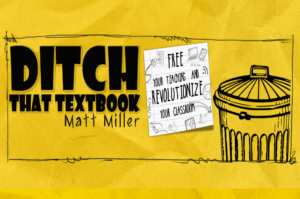A Blogging as Writing Curriculum

What a thrill! After reading my last post on blogging with my 6th-graders at my former school, my new 7th-grade colleagues embraced blogging for our grade level. As a result I have blended my previous experience with teaching writing as blogging with our more traditional writing curriculum. My hope is that this draft curriculum can serve as a transition to more vibrant and engaging writing program for today’s students.
Here is an abbreviated version of what I put together for my team.
Preparation/Set-up
Set your classroom blogging space in Kidblog or platform of your choice. We chose Kidblog because of its ease of use, opting for the “pro” account so our students would be able to personalize their blogs.
To start out, make your settings “tight” (ie., the teacher reviews all posts and comments at first), so students will be motivated earn their way towards more public sharing and that parents will have time to become comfortable with the transition to this new way of learning.
Send home a letter and permission form to inform parents and solicit their support (especially needed for students under the age of 13).
Write an “about me” post for your teacher blog, part of your shared “classroom” space. Your blog will be a great place to post assignments, share resources, or highlight “featured” blogs.
In the Kidblog classroom (and most other venues), students can join in two ways: you can provide each student with a username and password you have created (recommended; they can change the password once they are in), OR you can have students log in with a “class code.” If your students are using iPads, as mine will be, you will need to have them download the app for the blogging platform you have chosen. Option number one also seems to work better with iPads.
Blogging as Writing: A Curriculum
Quarter 1
Take time to introduce students to blogging as a platform for quality writing. Many students (and adults) still think of blogs as rambling, self-indulgent journal posts rather than a legitimate way to inform, reflect, or comment thoughtfully online. I stress how the blog is really a way to share, usually in essay form, with an authentic audience topics that interest you. All the standards of good writing apply!
Share blogs you like, especially ones by young people. Some of my recent favorites include Never Seconds, Animation Chefs, and Sylvia’s Super-Awesome Maker Show. You can also browse for good examples at the Edublog Awards for “Best Student Blog of 2013.” I stress how blogs are a way of communicating with the world — and possible making a difference.
Required Writing Assignment: Personal Narrative (“About Me” post)
Traditionally, a first blog post is about the writer of the blog. Students can write a short, introductory essay about themselves; I have them include a photo with this essay. (If students or parents are uncomfortable with sharing personal photos, they can compose a photograph that represents their topic.)
These topic choices can help students over the hump of getting started:
“My Life as a Writer”: Students look back on their development as writers and chronicle the important steps along the way to where they are now.
“Doing What You Love”: Students focus on the one activity that captivates them so much that they keep going back to it, overcoming failures and exploring new possibilities (a great way to have students discover their blogging focus).
Skills/Lessons
- What is a blog?
- Writing strategies (show don’t tell, word choice, scene setting, dialogue, organization and paragraphing, focus and unity, editing and proofreading, understanding audience)
- Using images to extend writing
- Tech stuff: Setting up a blog, adding tags, digital safety and digital citizenship, uploading images
Free Post 1
When students feel ownership for their writing, they care more about what they produce. Students should be encouraged to choose a topic about something that they are interested in or passionate about, something they feel enthusiastic about sharing with their readers.
Some students will jump right in; others will feel stymied. Struggling to find a topic that will interest readers and figuring out how to write about that topic are important parts of the learning process. Teachers will need to trust that students will want to discover writing forms, structures, and conventions related to whatever it is they choose to write about.
Give students some parameters: a length to shoot for (I suggest 300 to 500 words; some say the ideal length of a blog post is about 1,600 words), a challenge to try a new writing technique, accountability for editing and proofreading. Then get out of their way (of course, provide help in class as they write).
I usually ask students to include at least one image (if not original, they should include a photo credit), appropriate tags and one link to an internet source for further information.
Skills/Lessons
- Writing strategies: brainstorming topics, locating a focus, revising, writing/adding comments
- Tech stuff: Basic searching tips, adding links
Comments
Students write at least two comments on two different students’ blog posts, once they have been reviewed and released by the teacher. Commenting is important to blogging — it makes the writer’s sense of audience real! It also adds the sense of a public conversation, connection, and interactivity. Transparency and choosing one’s words carefully become equally important. Students learn how to extend the conversation rather than just “hit and run” with a quick jab or “like.” I stress that students should not assume the role of the teacher when writing comments; they should understand that a public blog is not the place for peer review or personal commentary.
Quarter 2
All posts and comments continue to be reviewed by the teacher before posting. They are getting better, but they’re not there yet!
Required Writing Assignment: Reading Response: Students write an extended response to a chapter or passage, a character study, a reaction to a poem, or other assigned focus. Students continue to use tags, links, and images.
Skills/Lessons
- Writing strategies: responding to literature; using details as support; more grammar, editing, and proofreading; citing resources (includes image/photo credits)
- Tech stuff: embedding video, maps, etc.; finding and using copyright-free images
Free Post 2
Students use another’s students blog post as a jumping off place for their own writing. This can be a response to structure or format, subject matter, point of view or any other choice made by the writer. This encourages more active reading of blog posts and reinforces the idea the they are all writers who can learn from each other. Students acknowledge and link to the other student’s post, which broadens its audience. Students should continue to include at images, links, and tags.
Skills/Lessons
- Writing strategies: responding to writer’s choices (word choice, tone/mood, structure, content), referencing other writers, acknowledging others’ work
- Tech stuff: creating a pull-out quote (optional), referring and linking to other blog posts
Comments:
Students continue to write at least two comments for full credit. They are encouraged, for extra credit, to do more.
Quarter 3
Students have a trial quarter of posting blogs and comments before teacher review. Parents are invited to view and comment. Depending on the focus of your class, you may want to bring your students’ creative writing into the blogging medium at this point. Our more academic focus is reflected below.
Required Writing Assignment: Thesis/Argument
Students continue to develop their formal responses to literature in the public venue of blogging. Students might post a tentative thesis and overview of a proposed argument. Peers could be instructed to ask questions for clarification and respond to the argument’s viability — these would count as comments. Students continue to include tags, links, and images (with photo/image credit if needed).
Skills/Lessons
- Writing strategies: crafting a thesis, finding evidence and using quotations, analysis
Free Post 3
Ask students to try something new — a new topic or a new approach to an old topic, a different format, a different way of interacting with readers. Have them review their earlier brainstorming of topics and ideas. Students could also do some browsing and reading of blogs or other sites of interest to make recommendations for further reading. Some time spent reviving creative juices may help students who are starting to become formulaic in their writing. Students continue to include tags, images, and links.
Skills/Lessons
- Writing strategies: creativity boosts
Comments: Students post two comments as usual. They should be improving significantly in their comment writing by this point.
Quarter 4
Student work is posted prior to teacher review — and is now open to comments outside the class (the world). Students are encouraged to share their blogs with five adults whose support they value and invite comments, the farther away the better.
Required Writing Assignment: Thesis/Argument with Quotations
This is the logical follow-up to the previous quarter’s assignment. Students can continue to post thesis and argument ideas, but also include possible quotations as support, before they shape their fully developed essay. Readers can be encouraged to comment with additional suggestions for quotations that might support the argument given. Students continue to use images, links, and tags for this post; this encouraging them to think figuratively and metaphorically with images, rather than just literally. I also like this emphasis on writing as a process.
Skills/Lessons
- Writing strategies: how to make “academic” writing more interesting and readable
Optional Writing Assignment: Final Reflection
Students should give some thought to how their writing and thinking have developed over the course of the year through their blogs. How they go about this should be up to them, so that this is still considered a free post. Some discussion of how to reflect honestly and openly may be in order. Students continue to use tags, links (perhaps to their own former posts), and images.
Skills/Lessons
- Writing strategies: reflection, questioning, and self-evaluation; evaluating others’ writing
Comments: Students use their comments during this round of blogging to nominate two peers’ posts, one each for “Best Required Post” and “Best Free Post.” The comment should say specifically why the nomination is being given (reinforcing the idea of using support and evidence for points). This is a powerful motivator and confidence boost; it encourages students to acknowledge the achievements of others and to learn from their successes.
Other Post Ideas: sharing poetry and other creative writing, housing videos projects,
researching and using vocabulary, posting about independent reading.
This is just the beginning for us! Please share your ideas for how you integrate blogging into a writing curriculum.
Photo Credits
Mike Licht, NotionsCapital.com via Compfight cc
Photo Credit: Mike Licht, NotionsCapital.com via Compfight cc







Kate Madison
I love the idea of creating a blog for just the writing piece of the curriculum. I have seen many teachers use blogging as a way to increase class discussion, but I never thought about using it as a platform for student writing. My school, however, does not have much for technology and some students don't have computers or the internet at home, so I feel this might be difficult to do on a regular basis. Have you ever had a situation with a parent refusing to give permission for his/her student to participate on the blog?
Replies
Susan Davis
Access, of course, is an issue. But I find that students have access on phones or can go to a local library or just use the access available at school. Blogging together in the classroom gives time for addressing the blogs as writing. I have had one or two parents deny access for their children to do the blogging. Usually, however, the parents come around when they see the other students' blogs and feel some pressure from their child to join the fun of writing for a real audience. Also, a face-to-face conversation can often clear up any fears or concerns they may have. If not, I give the child the option of writing in a more traditional format.
Chip Carnes
Hi Susan,
I absolutely love this idea for my classroom! I am finding that as the school year goes on, my students are less engaged with the writing process. I think this would be a great way for them to develop their writing skills and collaborate with the peers. They love using technology in the classroom so I think they will have more motivation than they do by just doing it paper/pencil. I also think typing it in Word and then submitting as a blog will help them with their conventions and sentence fluency. Thanks for the idea!
Chip Carnes
By the way, here is a link to my blog where I am encouraging others to think about using this great idea!
http://mrchipcarnes.blogspot.com/
James
The concept of literacy education has changed as technology has evolved. It is no longer enough to teach students how to read books and write on paper.
Jenniferfhughes
It is better to choose Kid blog because of its ease of use, opting for the “pro” account so our students would be able to personalize their blogs.I think this would be a great way for them to develop their writing skills and collaborate with the peers. They love using technology in the classroom so I think they will have more motivation than they do by just doing it.
Emilia Clarke
Great blog...Good information you have shared here..
Amy Saunders
Oh my goodness! I can't believe you just said that developing a personal blog can clearly improve our kids' computer and writing skills as well. Alright, I'll ask my nephew's son's teacher to take this action into consideration so everyone in the class can get better academically soon. He's been taking some feedback from parents on how to make his language lessons even more effective. https://www.scac.nsw.edu.au/high-school-enrolment